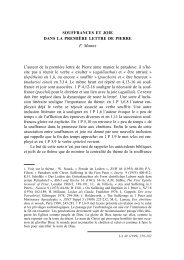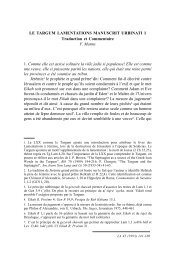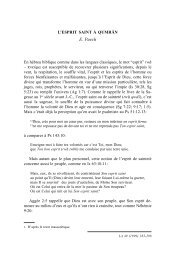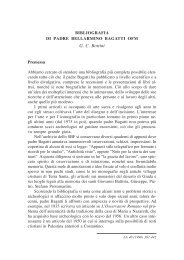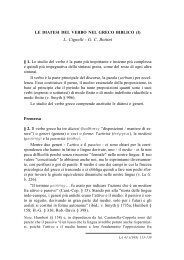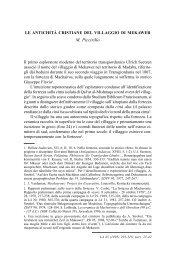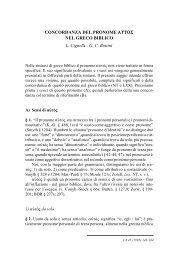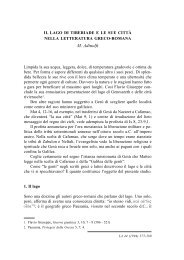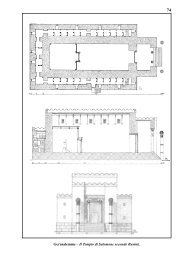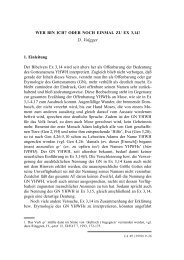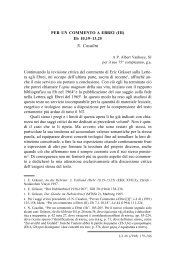Ricerca storico-archeologica in Giordania XVII – 1997
Ricerca storico-archeologica in Giordania XVII – 1997
Ricerca storico-archeologica in Giordania XVII – 1997
Create successful ePaper yourself
Turn your PDF publications into a flip-book with our unique Google optimized e-Paper software.
480<br />
RICERCA IN GIORDANIA<br />
81) separates it from the narthex, which was accessed by a door, whose sill<br />
and jambs were found <strong>in</strong> situ. At present, the extension of the area towards<br />
the south west, is not known. The stratigraphical analysis reveals that at<br />
surface level, a th<strong>in</strong> stratum of SU 0 was superimposed on SU 49, this latter<br />
characterized by numerous w<strong>in</strong>dow nets, fragments of glass and sherds<br />
cover<strong>in</strong>g a layer of squared-up homogeneous ashlars (structural fall = USM<br />
76 ?). The functions of this room (Locus 7) and its relation with the church<br />
are still to be determ<strong>in</strong>ed.<br />
Narthex<br />
The portion of the excavated narthex, correspond<strong>in</strong>g to the façade of the north<br />
church, has revealed a similar stratigraphical sequence already visioned <strong>in</strong> the<br />
1996 excavation: composed of SU 0, which covers SU 49, slightly <strong>in</strong>cl<strong>in</strong>ed<br />
<strong>in</strong> a north-east/south-west direction. This stratum, <strong>in</strong> turn covers SU 42, upon<br />
which was found a moulded column base (RA 66). Between the base and the<br />
external wall (USM 81) of locus 7, a dark brown soil stratum (SU 80) <strong>in</strong><br />
relation with a tabun was discovered. The sill to the door of the room (locus<br />
7) is set upon the narthex mosaic floor<strong>in</strong>g, identified through an exploratory<br />
probe.<br />
The Chapel<br />
The plastered raised platform, set on the west side of the chapel, and left untouched<br />
<strong>in</strong> the 1996 campaign, was violated by the locals show<strong>in</strong>g the presence<br />
of small artificial square cavity (0.75 × 0.75) plastered <strong>in</strong>side, conic<br />
shaped, and built directly on the bed rock. Its open<strong>in</strong>g was at the center of the<br />
plastered platform. The cavity was covered by a base of a column with a lateral<br />
hollow to facilitate its open<strong>in</strong>g.<br />
The raised plaster step, which conta<strong>in</strong>ed the cavity (SU 66), was covered<br />
by a vault and was externally closed by a wall, whose shape was not<br />
yet determ<strong>in</strong>ed. In the proximity of the step, the mosaic discovered last year<br />
showed a motive with two rampant lions on either sides of a medalion<br />
turned towards the cavity and not towards the opposed apse of the chapel;<br />
on the other hand two hollow embeds probably for small pilasters or a chancel<br />
screen were cut on both sides of the wall flank<strong>in</strong>g the step. These remarks<br />
bear testimony of a certa<strong>in</strong> importance of this structure with<strong>in</strong> the<br />
chapel itself.<br />
The excavation was also extended to the area located beh<strong>in</strong>d the apse<br />
of the chapel. It showed the presence of a quadrilateral room with four<br />
pairs of pilasters surmounted by reused imposts (though similar typologic-



